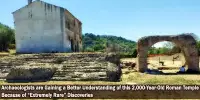Craco, a ghost town, and comune in the province of Matera, was formed in the eighth century and was a remarkable survival in the turbulent medieval period. Craco is located in the southern Italian province of Basilicata, and it is not available to the public because to safety concerns and the fact that many of the families who were forced to vacate their homes between the 1960s and 1980s still own them privately. Craco has become a renowned movie site and tourist attraction as a result of its abandonment. Craco was added to the World Monuments Fund’s watch list in 2010.
The town is perched 400 meters above sea level on a rock. The city core can easily be defended from the ordinary barbarian army because to the panoramic views. Towns are abandoned for a variety of causes, including natural disasters, factory or mine closures, as well as isolation and even modernity. The region was known as “Montedoro” and was inhabited by Greeks who had relocated inland from the seaside port of Metaponto in 540AD.
Tombs dating from the eighth century have been discovered, implying that the first settlement took place during that time. Craco has been abandoned as a result of earthquakes, landslides, and a lack of fertile farming land. The Gulf of Taranto is roughly 40 kilometers (25 miles) inland from Craco. For defensive purposes, the town was erected on a very high hill, which gave it a distinctive aspect and set it apart from the surrounding terrain.
Even without occupants, the town’s illustrious history has left a lasting legacy of medieval architecture. Built-in 1300, the majestic castle dominates the cliffside landscape. A chapel in Craco holds a statue of the Virgin Mary that was miraculously recovered in a nearby body of water, in addition to the castle. The town’s heart, constructed on the highest point, overlooks a ridge that extends sharply to the southwest, where modern structures may be found.

The settlement is perched on a 400-meter (1,300-foot) rock overlooking the Cavone River valley. Intensive erosion has created several vegetation-free mounds known as calanchi (badlands) across the region. The structures that we see now over the graves date back to 1060. Craco’s population expanded from 450 in 1276 to over 2500 by the 16th century, thanks to the establishment of a university. The town had been growing steadily, and by the nineteenth century, it had reached its limit.
Craco is situated on a hill in a picturesque but lonely location. When the newer portion of the town was destroyed by a landslide, which was at least partially caused by the construction of a modern road and the addition of private cisterns, the older half, which was still standing, was left without services and was finally abandoned. Eberto ruled the settlement for the first time from 1154 to 1168. Roberto di Pietrapertos ascended to the throne of Craco in 1179.
By 1276, the community had built a university. The iconic fortress was erected during this time period in the 13th century, under the leadership of Attendolo Sforza. The Castle Tower became a jail under Federico II in 1293, and by the 15th century, the town had developed to four big plazas. The population increased from 450 in 1277 to 2,590 in 1561, and then hovered around 1,500 for the next few centuries. In 1656, a disease hit, killing hundreds and drastically decreasing the population.
Craco entered feudal possession of Muzio Sforza in the 13th century, and a university was founded in the town in 1276. In 1815, the town was deemed substantial enough to be divided into two districts. Palazzo Maronna near the tower, Palazzo Grossi near the huge church, Palazzo Carbone on the Rigirones property, and Palazzo Simonetti were the four large palazzi in the town by the 15th century. A plague hit the town in 1656, killing hundreds of people and limiting the number of households.
Despite the fact that emigration has left Craco desolate, life returns to the town during one of the numerous religious festivals dedicated to the Virgin Mary and the statue. Between 1892 and 1922, around 1,300 Crachesi departed to settle in North America as a result of bad agricultural circumstances that rendered the area unfit for cultivation or grazing. Following that, the town was taken over by the Napoleonic occupation. On July 18, 1807, brigands aided by the exiled Bourbon government stormed Craco, looting and murdering pro-French notables.
Repeated earthquakes began to devastate the town in the mid-twentieth century. A succession of landslides seriously destroyed and left parts of the settlement uninhabitable between 1959 and 1972. The “Craco Society,” a non-profit organization dedicated to preserving Craco’s culture, customs, and history, was founded in 2007 by descendants of Craco emigrants in the United States.
Although the ancient town, in its many phases of deterioration, would be ideal for a haunted Hollywood film, there are no ghosts here. Craco is currently unoccupied in 2011. The final 1,800 residents were relocated to a valley in the Craco Peschiera area in 1963. Scenes from Mel Gibson’s Passion of the Christ, James Bond 007 Quantum of Solace, a number of other Italian films, and advertisements, including a Pepsi commercial shot just this year, have all been filmed in the town.
















